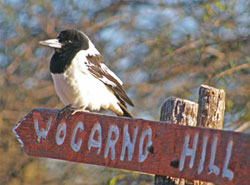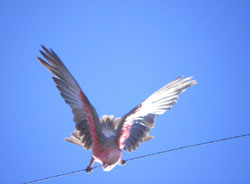17 October 2008
Birdsong in the Outback
Striking Gold in WA


© Chris Tate
In 1891, gold was discovered in Mount Magnet, prompting Western Australia's first gold rush. Although this remote mining centre has slowed significantly since its heyday, I struck gold here myself in 2002. Spread out across a paddock at Wogarno Station, three pied butcherbirds delivered up antiphonal song with a precision that called to mind the dovetailing of the medieval hocket (an effect creating a single melodic line). The tonal beauty and apparent musical sophistication of the birds stunned me. I began notating their phrases and never looked back.
A bird's song can function as deed to his territory – an auditory 'keep out' sign – or as a 'come hither' to his female counterpart, a serenade, if you will. It can serve as a group password. In fact, 'Why do birds sing?' involves a complex web of many correct answers and as many unanswered questions. However, it seemed clear to me then (and has remained so in my five-year study of their songs) that pied butcherbirds' vocal complexity transcends biological requirements. Function simply does not explain all the diversity in their song, which varies geographically, seasonally, and individually.
The advent of the tape recorder, followed by further technological advances such as digital recording and computer analysis programs, has allowed biologists to leapfrog over musicians and develop the study of avian acoustics and its concomitant behaviour. A groundswell of activity followed, much of it based on sonographic analysis. But consider this – dependence on the sonogram shifts the focus of birdsong from a trained ear to a trained eye. This is echoed in Western classical music when the score is privileged above the sonic experience. The sonogram does not represent what the human ear (and likely the bird's ear) hears. In my work, I pair music notation and sonograms.
Is musicality a capacity we share with other species? Do non-human animals derive pleasure from their sound production efforts? Are they capable of behaviour that is aesthetic? An affirmative answer would point to a biological basis to aesthetics, that music is somewhere there in the biology. Intriguingly, Eastern Gondwana (Australia and Papua New Guinea) is implicated as the birthplace of songbirds in recent 'If Homo sapiens learned music from birds, this continent is the birthplace of music.' papers citing DNA sequence data. If Homo sapiens learned music from birds, this continent is the birthplace of music.
True songbirds learn their songs, and some are known to appropriate human music and other human sounds into their vocabulary. The earliest published manual for training of singing birds dates from c. 1700; one is still in print, The bird fancyer's delight, used to teach canaries, nightingales, starlings, and other birds given to the human animal's sense of musicality.
Both species of Australian lyrebirds, the superb and the Albert's, appropriate human sounds without prompting, as do pied butcherbirds, often assembling these sounds in lengthy mimicry cycles. Birds take each others' stuff, use stuff, chop stuff up, re-stuff, and re-cycle – it's a natural continuum. It's the way musicians work as well. The natural world of bird can be slotted in both an ancient tradition and a postmodern one. Birdsong is authentic, original, by and large untainted, exotic, primitivist – it is 'other'.

One of my performance outcomes at the Sounds Outback Festival (3-5 October, Wogarno Station) was a bird whistle improvisation with Jon Rose. We began with Audubon birchwood and metal devices that we twisted and twirled in order to coax bird-like sounds from them, and continued with other whistles variously made out of metal, wood, clay, and plastic – they chirp, warble, squeak, croak, pipe, tweet, twitter, and, of course, whistle. We concluded with a pair of Crackle Boxes. The Kraakdoos, or Crackle Box, was designed by Michel Waisvisz at STEIM/Amsterdam in the 1970s. This touch- and pressure-sensitive device employs the human body as a part of the electronics. Finger contact makes it squeak and glitch, warble and wail, not unlike some birds.
Concert promoter Tos Mahoney asked me to play a few fiddle tunes as well, and, since Australia has never developed its own fiddle tradition (Australian fiddlers adhere to traditional tunes from the British Isles), I offered up some of my twisted arrangements of American hoedowns, rags, and bluegrass. The tunes seemed particularly appropriate in the shearers' shed.

© Hollis Taylor
The next morning, I was up early to record pre-dawn pied butcherbird phrases, until interrupted by a raucous flock of galahs. 'We're pink, we're grey, we're pink,' they signaled, as they wheeled across the sky. Their shrill chri-chris accompanied wild landings on the diagonal wires supporting the television aerial. The galahs abseiled down the wires with their beaks, sometimes somersaulting as they went.
Later that day, station owner L.J. Campbell gave me a tour of several western bowerbird bowers. One mound of twigs over a metre in diameter had an avenue bower constructed atop it, its walls painted yellow. While the bowerbird painted in yellow, his decorating tastes run to things green and white (unlike my local satin bowerbird in the Blue Mountains, who has a preference for blue, with yellow a second choice). The western bowerbird had an elaborately decorated 'welcoming mat' of green or white seedpods, broken glass, shells, stones, skeletons, feathers, and other found objects. The avenue bower is not a nest – it is where he sings and dances and lures the female in, and where they would mate if successful.
Vocalists, composers, improvisers, architects, decorators, painters, dancers… it would seem anthropomorphic not to entertain the idea that aesthetics exist in species apart from the human animal.
Further links
Hollis Taylor - AMC (www.amcoz.com.au/composers/composer.asp?id=29916)
Hollis Taylor - personal homepage (http://www.hollistaylor.com)
Jon Rose (http://www.amcoz.com.au/composers/composer.asp?id=143)
Sounds Outback Festival (www.tura.com.au/events/regional/sounds_outback2008/)
STEIM (www.steim.org/steim)
© Australian Music Centre (2008) — Permission must be obtained from the AMC if you wish to reproduce this article either online or in print.
Subjects discussed by this article:
Hollis Taylor is a violinist/composer who recently completed her PhD in the song of the pied butcherbird.
Comments
Add your thoughts to other users' discussion of this article.
You must login to post a comment.
A swift story...
by Angharad on 17 October, 2008, 10:45pm
To my mind, one of the great side benefits of the (musical) ornithological obsession is the ever-expanding repertoire of delightful anecdotes.
In terms of the aesthetic sensibilities of birds, I think it's hard to go past the legendary BBC broadcast of cellist Beatrice Harrison playing a duet with a nightingale. As far as their rapacious appetite for new musical material goes, Francois-Bernard Mache (I think) recounted how a particularly unusual blackbird song - and its increasingly distant variants in nearby areas - was eventually traced back to a particular family, who had picked it up from the sound of a man who lived near their tree calling his cat home at dusk every day.
Flute-playing superb lyrebirds of Dorrigo
by hollis on 20 October, 2008, 5:49am
The flute-playing superb lyrebirds of Dorrigo are a case in point as well. In the 1920s, a juvenile Superb Lyrebird in captivity, unable to hear adult lyrebirds, modeled his singing on what he could hear: the practice routine of a flute student. He learnt a scale and two simple melodies, “Keel Row” and “The Mosquito Dance.” Lyrebirds are superb mimics, and so in addition to matching the melodies in pitch and tempo, he sang with the tonal quality of a flute.
When released back into the wild, he would have continued his flute songs while also picking up songs and mimicry used by the wild population. They, in turn, could not afford to let him be outstanding in competing for females and would have copied his flute songs. And note this happy coincidence: Superb Lyrebird territorial songs in many localities include sequences of repeated notes—the same note repeated many times. Our hero's scale consisted of repeated notes, but with the added interest of rising pitch.
His flute songs were then culturally transmitted down the years, spreading through the lyrebird population and replacing the original territorial song. Australian ornithologist Syd Curtis relates this story in a paper we are currently publishing on his memories of Olivier Messiaen, whom he sent recordings to of various Australian birds.